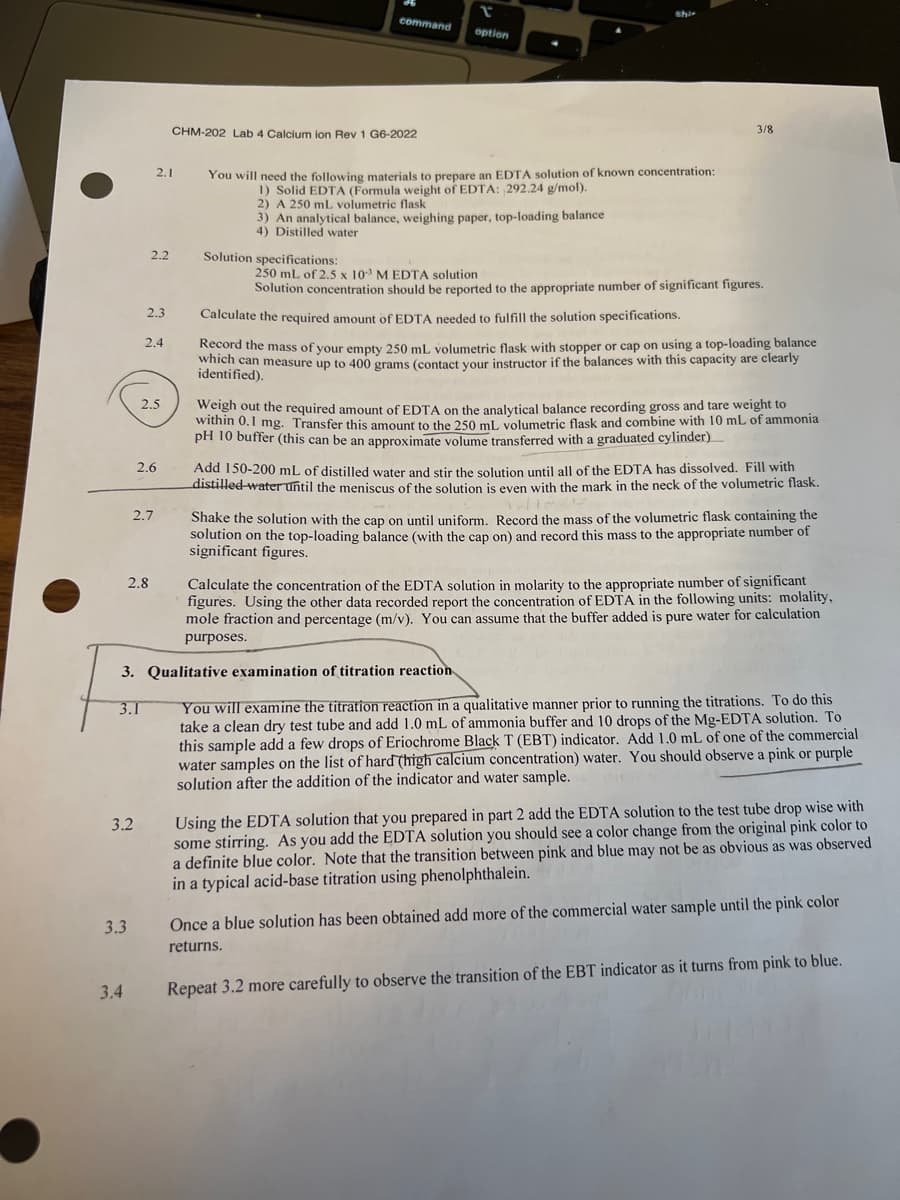Chapter17: Complexation And Precipitation Reactions And Titrations
Section: Chapter Questions
Problem 17.17QAP
Related questions
Question
100%
I need to complete concentration of EDTA
![CHM-202 Lab 4 Calcium ion Rev 1 G6-2022
Preparation of EDTA solution (show calculations below)
250mL of 2.5 X 103m
m= n/
m 0.0025m=
250 ML
n = 0.625 mmides = on = 0.625 x 10²³ moles
Grams of EDTA Required
Mass of EDTA [2.61
Analytical Balance
182.3
Moles of EDTA
10.000 625
Mass of water in solution
Molarity
Molality
miligram.
Mole Fraction
Percentage (m/v)
292.24
MWEota g/mol
0.182 105.
Tare
Weight
Mass of Solution [2.4, 2.7]
Top Loading Balance
102.04 mg
5/8
Gross
Weight 351.520
249 2977
Concentration of EDTA [2.8] Use both correct units and significant figures
mg.
Net
Weight 249 480 mg.](/v2/_next/image?url=https%3A%2F%2Fcontent.bartleby.com%2Fqna-images%2Fquestion%2Fc90b0127-0ec9-4235-9d49-12cd32f94657%2F6bee8a7b-635d-424c-b77c-cc44f4589a9c%2Fg9swjsq_processed.jpeg&w=3840&q=75)
Transcribed Image Text:CHM-202 Lab 4 Calcium ion Rev 1 G6-2022
Preparation of EDTA solution (show calculations below)
250mL of 2.5 X 103m
m= n/
m 0.0025m=
250 ML
n = 0.625 mmides = on = 0.625 x 10²³ moles
Grams of EDTA Required
Mass of EDTA [2.61
Analytical Balance
182.3
Moles of EDTA
10.000 625
Mass of water in solution
Molarity
Molality
miligram.
Mole Fraction
Percentage (m/v)
292.24
MWEota g/mol
0.182 105.
Tare
Weight
Mass of Solution [2.4, 2.7]
Top Loading Balance
102.04 mg
5/8
Gross
Weight 351.520
249 2977
Concentration of EDTA [2.8] Use both correct units and significant figures
mg.
Net
Weight 249 480 mg.

Transcribed Image Text:3.1
3.2
3.3
3.4
2.2
2.3
2.1
2.4
2.7
2.8
2.5
2.6
CHM-202 Lab 4 Calcium ion Rev 1 G6-2022
command
T
option
You will need the following materials to prepare an EDTA solution of known concentration:
1) Solid EDTA (Formula weight of EDTA: 292.24 g/mol).
2) A 250 mL volumetric flask
Solution specifications:
3) An analytical balance, weighing paper, top-loading balance
4) Distilled water
3/8
250 mL of 2.5 x 10 M EDTA solution
Solution concentration should be reported to the appropriate number of significant figures.
Calculate the required amount of EDTA needed to fulfill the solution specifications.
Record the mass of your empty 250 mL volumetric flask with stopper or cap on using a top-loading balance
which can measure up to 400 grams (contact your instructor if the balances with this capacity are clearly
identified).
Weigh out the required amount of EDTA on the analytical balance recording gross and tare weight to
within 0.1 mg. Transfer this amount to the 250 mL volumetric flask and combine with 10 mL of ammonia
pH 10 buffer (this can be an approximate volume transferred with a graduated cylinder)
3. Qualitative examination of titration reaction.
You will examine the titration reaction in a qualitative manner prior to running the titrations. To do this
take a clean dry test tube and add 1.0 mL of ammonia buffer and 10 drops of the Mg-EDTA solution. To
this sample add a few drops of Eriochrome Black T (EBT) indicator. Add 1.0 mL of one of the commercial
water samples on the list of hard (high calcium concentration) water. You should observe a pink or purple
solution after the addition of the indicator and water sample.
Add 150-200 mL of distilled water and stir the solution until all of the EDTA has dissolved. Fill with
distilled water until the meniscus of the solution is even with the mark in the neck of the volumetric flask.
Shake the solution with the cap on until uniform. Record the mass of the volumetric flask containing the
solution on the top-loading balance (with the cap on) and record this mass to the appropriate number of
significant figures.
Calculate the concentration of the EDTA solution in molarity to the appropriate number of significant
figures. Using the other data recorded report the concentration of EDTA in the following units: molality,
mole fraction and percentage (m/v). You can assume that the buffer added is pure water for calculation
purposes.
Using the EDTA solution that you prepared in part 2 add the EDTA solution to the test tube drop wise with
some stirring. As you add the EDTA solution you should see a color change from the original pink color to
a definite blue color. Note that the transition between pink and blue may not be as obvious as was observed
in a typical acid-base titration using phenolphthalein.
Once a blue solution has been obtained add more of the commercial water sample until the pink color
returns.
Repeat 3.2 more carefully to observe the transition of the EBT indicator as it turns from pink to blue.
Expert Solution
This question has been solved!
Explore an expertly crafted, step-by-step solution for a thorough understanding of key concepts.
This is a popular solution!
Trending now
This is a popular solution!
Step by step
Solved in 5 steps

Knowledge Booster
Learn more about
Need a deep-dive on the concept behind this application? Look no further. Learn more about this topic, chemistry and related others by exploring similar questions and additional content below.Recommended textbooks for you


Principles of Instrumental Analysis
Chemistry
ISBN:
9781305577213
Author:
Douglas A. Skoog, F. James Holler, Stanley R. Crouch
Publisher:
Cengage Learning



Principles of Instrumental Analysis
Chemistry
ISBN:
9781305577213
Author:
Douglas A. Skoog, F. James Holler, Stanley R. Crouch
Publisher:
Cengage Learning
